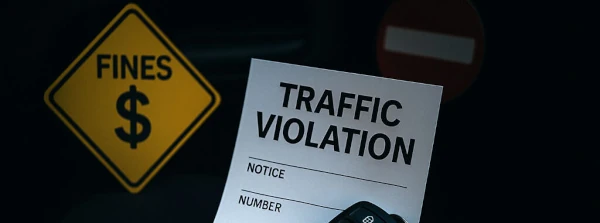 For the sake of making my point, I'm going to divide drivers who commit traffic violations into three categories; those that don't know the rules, those that make honest mistakes and those who are selfish and don't think about what their actions might result in.
For the sake of making my point, I'm going to divide drivers who commit traffic violations into three categories; those that don't know the rules, those that make honest mistakes and those who are selfish and don't think about what their actions might result in.
I know that I try my best not to be in the first category and despite my best efforts am occasionally part of the second category. Hopefully I am never in the last category.

Licensed Drivers are Expected to Know the Rules
The holder of a valid BC driver's licence should not be included in the first category. When we are licensed we are expected to know the rules and keep up with them even as they change. That is not always easy to do, but worth the effort because you cannot use "I didn't know!" as a defence to traffic violations in court.
People do Make Honest Mistakes
We all make mistakes, even when we don't want to. I accept that and try not to repeat them when I find that I am the culprit. I am very fortunate that I have not had to ask for someone's forgiveness, nor give it, through involvement in a significant traffic incident. Thank goodness!
Drivers Who Do Not Care About Others
This leaves us with the last group, those that don't want to be bothered to follow the rules unless it suits them to. Individuality, civil disobedience, I should be able to do this and other justifications have no place on our highways, they lead to collisions and they hurt people.
If you drive like this, shame on you! Perhaps if you hear this often enough from others you will consider not being a bad example.
Choose Not to Commit Traffic Violations
The traffic rules are there to keep us safe. By following them we avoid committing traffic violations that lead to traffic tickets and crashes. We're predictable drivers and other road users know what to expect from us.
Learn More
Share This Article
This may be totally off topic, but do you think regular, mandatory re-testing (road test) and/or driver education classes for all drivers would help, say, every 5-10 years? It seems a person gets his/her license once, and then can potentially generates a lifetime worth of either bad habits or a bad attitudes, and the only time it comes to the attention of anyone is when they get into a collision, by which time people have been hurt. It doesn't seem like a good system we have going on! I realize that while teaching people driving skills is relatively easy, trying to instill a good attitude in someone is not (necessarily).
There's also an issue (I think) with people who get their license and then for some reason do not drive for an extended period, but they keep renewing their license. Then one day they start driving again. Will this driver be safe on the roads? Is he/she going to remember all of the rules? Have they kept up with changes to the laws, roads, etc? Can I trust that if he/she doesn't feel confident driving that he/she will either chose not to drive, or will take a refresher course, or will they drive anyway, and potentially be a danger to themselves and to others?
- Log in to post comments
I think the system should work with the number of points you have accumulated in a certain amount of years or by being involved in crashes where the "I didn't know" was the reason for the crash.
My DL is clean and I make a point of checking on things. Am I the odd one here?
- Log in to post comments
It seems a miracle that more people are not killed or injured crossing the street. A lot of people jay-walk (cross the street not at an intersection, some cross at crosswalks without looking if the traffic has stopped for them, usually while texting, While others cross correctly and legally but the drivers are in too much of a hurry to get going to allow the pedestrian time to cross the road. The other day while crossing the road, a pickup had a near miss with me. Had I not seen the truck start to move just as I cleared the hald-way point of the road, I would likely not be writing this today or any day.
On top of that, the RCMP in this town set the example and don't obey too many traffic laws including crosswalks, turning across double solid lines and racing to beat the light. If they can do it here, what are the new drivers going to learn to do, but hey if the cops can do it so can I.
- Log in to post comments
Jaywalking is only illegal if there is a bylaw prohibiting it in a municipality. Otherwise, a pedestrian not in a crosswalk is required to yield to vehicular traffic.
One may turn across double solid lines legally in some circumstances.
- Log in to post comments
If it is legal to cross a double solid line to get into a business or mall or gas station, what is the point of having a double solid line, a dash line serves the same purpose and reduces the confusion. Also the jaywalking situation was talking about safety for pedestrians and vehicles. Too many pedestrians assume they always have the right of way and just walk out in front of vehicles with zero time to stop then blame the drivers for not paying attention, especially when they walk out between parked vehicles or at night have dark clothes on. There are no right times to break traffic laws for anyone but especially for the police as they are so visible to the public and recently have been involved in many negative public relations incidents. In this town a lot of people don't trust the cops so when they break the traffic laws in public it reinforces that mistrust.
- Log in to post comments
Solid yellow lines have to do with whether you can pass or not. So the point of having a double solid yellow line is so that people know that overtaking another moving vehicle is illegal.
A dashed yellow line is completely different; one dashed yellow line means cars in both directions could overtake moving vehicles if safe.
You can turn left across the lines if you are not impeding traffic in doing so. In other words, if there's a big line of traffic behind you and you're turning left across the lines in the middle of rush hour, causing an even bigger traffic jam behind you, then you aren't allowed to do it and could get a ticket for holding up traffic or something like that. Otherwise, if you aren't bothering anyone by doing it, then go for it. In other words, use discretion.
- Log in to post comments
This is railway crossing in Abbotsford, BC- there are two RED LIGHTS. Many drivers cross active red light and park on top of lane [ at second red light ]
I have discussed this crossing in FB and users were divided. Many confirmed that if space is available for safe parking, you can cross RED LIGHT and park at top of lane.
My Understanding is that RED LIGHT SHOULD NEVER be crossed, space available or not. Please clerify
- Log in to post comments
I adjusted your post to trade the static image for the Google Maps view of the intersection.
I see what you mean and the first red light is not at an intersection.
"intersection" means the area embraced within the prolongation or connection of the lateral curb lines, or if none, then the lateral boundary lines of the roadways of the 2 highways that join one another at or approximately at right angles, or the area within which vehicles travelling on different highways joining at any other angle may come in conflict;
I've talked about that in the article titled Red Means Stop, But Not Always Stay.
You could move ahead, but it is probably not a wise choice, especially if there is not 5 m between your back bumper and the nearest rail.
- Log in to post comments
I suspect they mean the "pre-signal" on the near side of the stop bar meant to stop drivers from entering the track area (this pre-signal has its own double stop bar before the tracks) when the traffic l lights are red (the vehicle ones, not the rail ones). Drivers love to pass these pre-signals where they exist when there is no vehicle waiting at the "normal" stop bar.
I guess a judge would need to decide if the pre signal is "at an intersection" or not and if the requirement to stop and wait at a red light applies to them.
- Log in to post comments
- Log in to post comments

This may be totally off